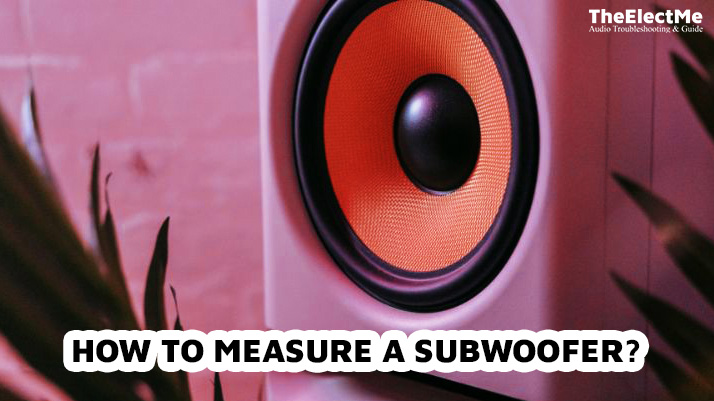Measuring a subwoofer involves determining its diameter, mounting depth, and cutout diameter. These measurements affect how the subwoofer fits into its enclosure and influence its performance.
Imagine fitting a large subwoofer into a small car without knowing its dimensions beforehand. The result could be a poor fit and subpar sound quality. Similarly, installing a subwoofer with insufficient mounting depth can lead to inadequate performance.
Therefore, accurate measurement of the subwoofer ensures optimal sound output and longevity of the device. But how to measure a subwoofer without any experience or knowledge? Keep reading to find out.

Let’s start with what type of tool you need to measure a subwoofer.
Tools You Will Need To Measure A Subwoofer
To accurately measure a subwoofer, you will need the following tools:
- Tape Measure: A flexible ruler helps measure the size of the subwoofer. It’s ideal for measuring larger distances a regular ruler can’t cover.
- Ruler: A ruler is useful for measuring smaller dimensions. It gives accurate measurements for smaller parts of the subwoofer where a tape measure may be too bulky.
- Straight Edge: This tool can help ensure precise measurements by providing a straight line for reference.
- Marker or Pencil: You’ll need this to mark measurements on your subwoofer or jot down dimensions.
- Notepad: A notepad is essential for recording all the measurements you take. It helps avoid confusion and mistakes.
- Calculator: A calculator helps do any necessary arithmetic involved in the measurements, especially when dealing with complex installations.
- Flashlight: If you’re working in a low-light environment, a flashlight can help illuminate the subwoofer, making it easier to see and measure.

Having these tools at hand will make measuring your subwoofer smooth and error-free.
Related: Woofer Vs Subwoofer: Which Is The Better Bass Provider?
How To Measure A Subwoofer With Just 7 Simple Steps?
Do you have all the necessary tools? Let’s get started with measuring your subwoofer using these 7 simple steps:
Step 1 – Preparing Your Subwoofer for Measurement
When it comes to measuring a subwoofer, preparation is key. Here’s how to get started:
Begin by ensuring the subwoofer is unplugged from any power source. This is an important safety measure to prevent any potential electrical shocks or damage to the equipment.
Next, remove the subwoofer from its enclosure if it is already installed. Depending on the enclosure’s design, this might require unscrewing bolts or unclipping fasteners. Be careful not to damage the subwoofer during this process.
Ensure you have a clean, flat surface to place your subwoofer on for measurement. A table or a workbench would be ideal. If the surface is hard, consider placing a soft cloth underneath to prevent scratches on the subwoofer.
Finally, gather all the necessary tools listed in the previous section. Having everything within reach will make the measurement process easier and more efficient.
Step 2 – Measuring the Diameter
Measuring the diameter of a subwoofer can be done in a few simple steps:
- Locate the Cone: The cone is the circular part of the subwoofer that moves in and out, producing sound waves. It’s typically made of paper, plastic, or metal.
- Position Your Measuring Tool: Using a tape measure or ruler, align the tool’s end with the subwoofer cone’s outer edge. This is where the cone meets the surrounding frame (the basket).
- Measure Across: Extend your measuring tool straight across the middle of the cone to the opposite edge. Be sure to measure from the outside edge of the cone, not the inside. This measurement is the diameter of the subwoofer.
- Double Check: To ensure accuracy, it’s recommended to take this measurement in a couple of different spots and average them together.
Remember to note down the measurement on your notepad.

Step 3 – Measuring the Mounting Depth
The mounting depth of a subwoofer is an essential measurement to ensure it fits correctly in its enclosure. Here’s how to measure it:
- Identify the Mounting Surface: This subwoofer part will be flush with the enclosure upon installation. It’s usually the flat rim surrounding the cone.
- Position Your Measuring Tool: Place the end of your tape measure or ruler on the mounting surface.
- Measure Straight Down: Extend your measuring tool to the furthest point at the back of the subwoofer. Depending on the subwoofer’s design, this could be the back plate or magnet.
- Record the Measurement: Note the measurement from the mounting surface to the back of the subwoofer. This is your mounting depth.
- Double-check: As always, double-check your measurement for accuracy.
The mounting depth is critical when selecting an enclosure for your subwoofer. Too shallow, and the subwoofer might not fit; too deep, and you may have unnecessary extra space.
Related: Step-By-Step Guide On How To Test Subwoofer Like A Pro
Step 4 – Measuring the Cutout Diameter
The cutout diameter is the hole in your speaker enclosure where the subwoofer will be installed. Here’s how to measure it:
- Locate the Frame: The frame, also known as the basket, is the part of the subwoofer that surrounds the cone. It’s usually made of metal or plastic.
- Position Your Measuring Tool: Align the end of your tape measure or ruler with the inside edge of the subwoofer frame. This is where the subwoofer would be mounted into the enclosure.
- Measure Across: Extend your measuring tool straight across the inner part of the frame to the opposite inside edge. This measurement is the cutout diameter.
- Double-check: As always, it’s wise to double-check your measurements in a few different spots to ensure accuracy.
The cutout diameter is essential for installing your subwoofer into an enclosure. It ensures that your subwoofer will fit perfectly into the hole cut into the enclosure.
The subwoofer will only fit properly if the cutout diameter is bigger. It may only be secure correctly if manageable, affecting performance and potentially causing damage.

Tips for Accurate Subwoofer Measurement
To ensure the accuracy of your subwoofer measurements, here are some pitfalls to avoid:
- Measuring the Wrong Part: Make sure you’re measuring the correct parts of the subwoofer. For example, the diameter should be measured from the outside edge of the cone, not the inside.
- Forgetting to Measure Mounting Depth: Many people focus on the diameter and must remember to measure the mounting depth. It could lead to a subwoofer not fitting properly in its enclosure.
- Using the Wrong Units: Be consistent with your units of measurement. If you measure the diameter in inches, measure the depth in inches, too.
- Rounding Up or Down: It’s important to be precise when taking measurements. Errors occurred during generation. Please try again or contact support if it continues.
Follow these steps to select your sound system’s perfect subwoofer and enclosure. Avoid common mistakes and ensure accurate results.
Final Thoughts – How To Measure A Subwoofer?
How to measure a subwoofer? Gather the tools and equipment to start safely. Measure the diameter, mounting depth, and cutout diameter accurately. Finally, double-check your measurements to ensure accuracy.
Subwoofer specifications are essential to consider when building or upgrading a sound system. You can choose the right subwoofer and enclosure for optimal bass performance by taking accurate measurements.
Remember to refer back to your measurements when shopping for a subwoofer. You can enjoy a well-balanced and powerful bass in your sound system with the right size and fit.



